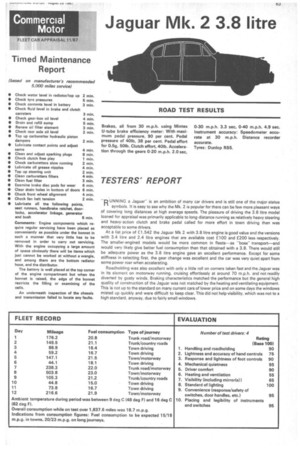TESTERS' REPORT
Page 65

If you've noticed an error in this article please click here to report it so we can fix it.
" pt UNNI NG a Jaguar" is an ambition of many car drivers and is still one of the major status " symbols. It is easy to see why the Mk. 2 is popular for there can be few more pleasant ways of covering long distances at high average speeds. The pleasure of driving the 3.8 litre model loaned for appraisal was primarily applicable to long-distance running as relatively heavy steering and heavy-action clutch and brake pedal called for more effort in town driving than was acceptable to some drivers.
At a list price of 1. 542 the Jaguar Mk 2 with 3.8 litre engine is good value and the versions with 3.4 litre and 2.4 litre engines that are available cost £100 and £200 less respectively.
The smaller-engined models would be more common in fleets as ''boss" transport-and would very likely give better fuel consumption than that obtained with a 3.8. There would still be adequate power as the 3.8 litre engine gave an excellent performance. Except for some stiffness in selecting first, the gear change was excellent and the car was very quiet apart from some power roar when accelerating.
Roadholding was also excellent with only a little roll on corners taken fast and the Jaguar was in its element on motorway running, cruising effortlessly at around 70 m.p.h. and not readily diverted by gusty winds. Braking characteristics matched the performance but the general high quality of construction of the Jaguar was not matched by the heating and ventilating equipment. This is not up to the standard on many current cars of lower price and on some days the windows misted up quickly and were difficult to keep clear. This did not help visibility, which was not to a high standard, anyway, due to fairly small windows.












































































































